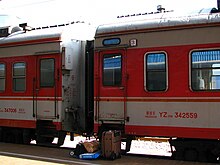| This article needs additional citations for verification. Please help improve this article by adding citations to reliable sources. Unsourced material may be challenged and removed. Find sources: "K-series trains" – news · newspapers · books · scholar · JSTOR (October 2018) (Learn how and when to remove this message) |

The K series (Chinese: 快速旅客列车) is a train service speed level by China Railway. K stands for "kuaisu" (lit. 'fast-speed'). However, they are likely to be the most commonly seen trains in China. Those trains make less stops than the number-only trains, but run at the same speed as them. For this, the K-series are sometimes mentioned as "Keng" (a scam) by Chinese Railfans. Train numbers are written in the form of K*** or K****, but the letter K reads as "kuai (快)" in station announcements and radio contacts.
History
1997–2004
The K-series trains first appeared in the first railway speed-up campaign as a service speed level, lower than the T-series but faster than the number-only series. The letter K was used in a train number for the first time in China. All the train numbers in the level were K***.
2004–2009
With more and more short-distance K-series trains are made, the idea of N-series (管内列车) level was brought up in the fifth railway speed-up campaign. The train numbers were in the N*** form.
2009–
The N-series was combined into the K-series again, for the appearance of K7*** series.
Rolling stock
Most K-series trains run using air-conditioned China Railways 25G rolling stock for carriages.
A few K-series trains use China Railways 25B, 25 or 22 rolling stocks, which are usually not air-conditioned and even coal-heated in winter. The 22 rolling stocks for K-series are most commonly seen in the northeastern part of China, where some railway lines cannot support 25G carriages to run on.

The 25T rolling stocks on K-series trains are really rare to be found. They are usually on the temporary trains, such as K5031/2 Dalian–Changchun service, which is only available on national holidays.
Train numbers
Trains are arranged into pairs, one for a direction (usually called upward (上行) for trains getting closer to Beijing or from branches to mainlines, and downward (下行) for trains getting farther from Beijing or from mainlines to branches), divided in a slash (/). For example, the Beijing-Moscow train via Ulaanbaatar is numbered K3, while the returning one numbered K4, so the pair is K3/4. Some pairs of trains have more than two train numbers, for an upward trains may become a downward train for they pass through Beijing or certain points.
In 2009, all the K-series trains are fixed to certain numbers arranged in a set of rules.
K-series trains numbered K1 to K3998 represents inter-bureau trains, which runs longer distances than others. Including international trains.
Train numbers K4001 to K4998 represents inter-bureau temporary trains, or former L-series.
Train numbers K5001 to K6998 represents inner-bureau (or regional) temporary trains, also former L-series.
Train numbers K7001 to K9998 represents inner-bureau trains. Most of them run on regional routes, however some of them also run a longer distance, for the larger bureau responsibility areas.
See also
References
- "快速旅客列车运行办法 - 法规库 - 110网". www.110.com. Retrieved 2018-07-13.
- A和N字头列车4月后被取消 增加G和C字头 Archived 2012-09-07 at archive.today. 文新传媒. 2009年3月27日.
| Passenger rail transport in China | |
|---|---|
| Accommodation |
|
| Train classes | |